
Fact Sheets And Publications
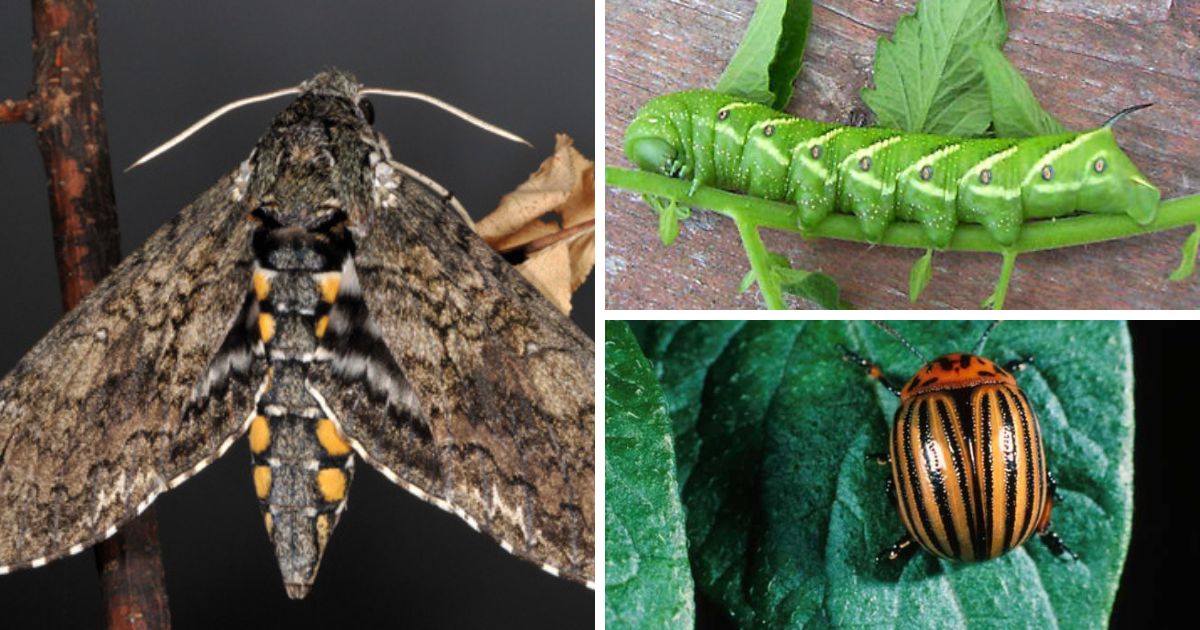
Non-chemical pest control options for managing insect pests on Solanaceous plants
(Tomatoes, potatoes, eggplants, peppers)
July and August in the vegetable garden typically bring bountiful harvests of colorful vegetables. These are also the months when insect pests can really make their presence known, with plant and fruit damage becoming increasingly noticeable.
Jump to: Colorado Potato Beetle | Tomato Hornworm and Tobacco Hornworm
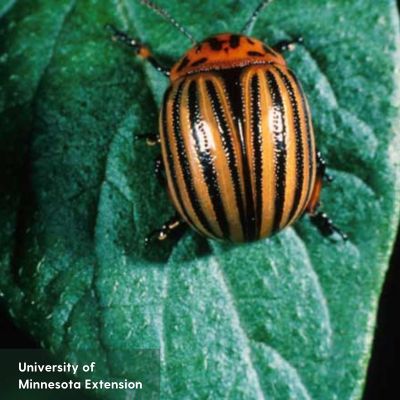
Colorado Potato Beetle
Crops attacked
Potatoes and eggplant are favored host plants, but they may also feed on tomatoes and peppers and on solanaceous weeds.
Type of damage
Both adults and larvae feed on leaves. Massive defoliation can occur if the population is not controlled.
Life cycle with suggested control methods (in bold)
- Adults overwinter in the soil, emerging in spring to feed on newly sprouted host plants. They mate and lay eggs, usually on the underside of leaves, in clusters of approximately 20 to 60 eggs.
- Eggs are bright yellow-orange.
- Larvae feed continuously on leaves, then drop to soil where they pupate. Typically two generations occur in our area.
- Keep a close eye on plants to spot and destroy adults as soon as they appear. The slow-moving beetles typically drop when disturbed; place a container of soapy water under them to trap and drown them.
- Crush any eggs and larvae (or drown larvae in soapy water).
- Row covers can be used to exclude adults (and can be left on throughout the season since pollinators are not required for the production of potatoes underground). Note eggplant, peppers, and tomatoes are self-fertile but require wind or insect movement for pollination, so they should not be covered.
- Straw/ thick mulch pulled over plants will reduce the number of adults settling on plants and encourage predators that feed on eggs and larvae.
- Rotate crops as much as possible to slow adult host-finding.
- Growing potatoes only every other year may help reduce beetle populations, if:
- No potatoes are being grown within a radius of ¼ to ½ mile away, and
- Temperatures are not excessively warm.
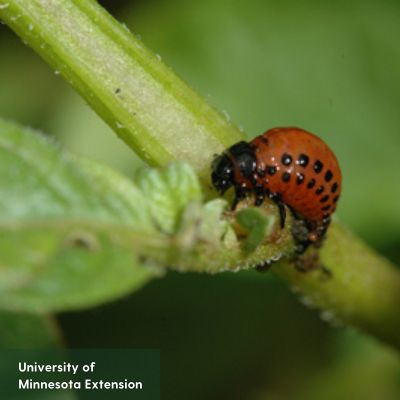
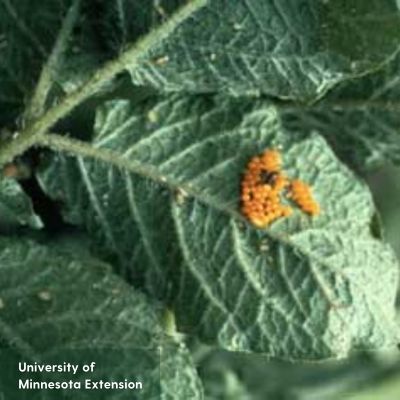
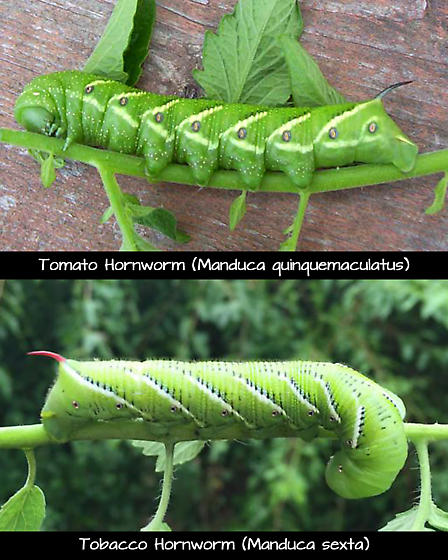
Bottom: Tobacco hornworm (7 stripes, like “Lucky Stripe” cigarette, red horn like lit cigarette end)
Photo courtesy of Robert Lord Zimlich, BugGuide.net
Tomato Hornworm and Tobacco Hornworm
Crops attacked
Both species feed on tomatoes and occasionally on other solanaceous plants such as eggplant, pepper, and potato.
Type of damage
The caterpillars eat the foliage. However, damage is often not noticed until the final caterpillar instar, when 90% of defoliation occurs.
How can you find them when they are smaller?
- Be alert for light feeding at plant tops. Mostly interior leaves are eaten (vs. deer that browse on outside of plant).
- Look for dark greenish-black droppings (frass) on the foliage under the caterpillars.
- Spray water on plants or run your hand over the leaves; this agitates the hornworms and makes them easier to spot.
- Shine a UV flashlight on your plants at night. The caterpillars glow under UV light.
- Hold a piece of white paper against the plant. Tomato branches with missing leaves will be evident.
Once large caterpillars are found, they are often parasitized by tiny braconid wasps. The cocoons of these wasps look like grains of rice attached to the hornworm's back. Do not kill parasitized hornworms. Let the wasps complete their lifecycle so they can multiply. A parasitized hornworm stops eating and eventually dies.
Life cycle with suggested control methods (in bold)
- Adult moths emerge over a long period beginning in May and extending as late as early August; there may be a second generation, with moths emerging in mid-summer
- Eggs are laid singly on leaf undersides, rarely on top: smooth, round eggs resemble small pearls; vary in color from yellow/light green to white.
- Crush eggs if found.
- Handpick caterpillars and drown them in a container of soapy water.
- Hornworms overwinter in pupal cases 4-6" deep in the soil.
- Tilling garden soil in spring or fall may expose and kill the pupae.
Note that in addition to parasitoids, there are many predators that eat the protein-rich hornworm caterpillars, including birds, small animals, and other insects. Paper wasps also use the caterpillars as food for their larvae in nest cells containing the wasp's eggs. Eggs and small larvae are attacked by lady beetles, minute pirate bugs, green lacewing larvae, and spined soldier bugs.
- Encourage predators and parasitoids by including a diversity of native flowering plants in and around garden beds.
- Insecticides are not usually warranted for this pest.
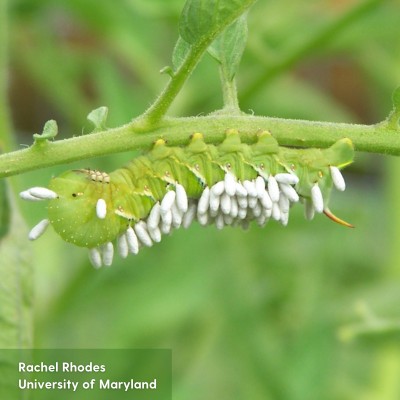
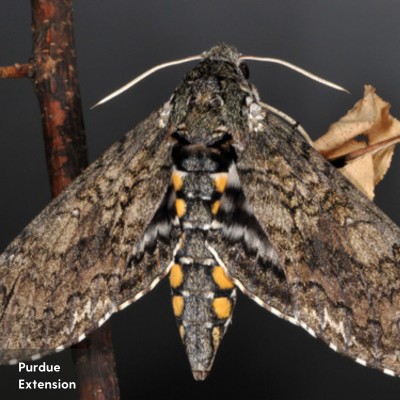
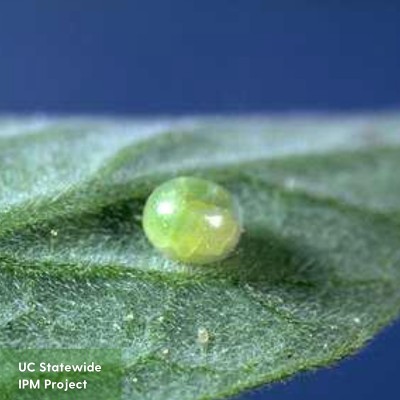
This factsheet was created for UD Cooperative Extension and the Delaware Master Gardener Program by Dr. Judy Hough-Goldstein.
UD Cooperative Extension
This institution is an equal opportunity provider.
In accordance with Federal law and U.S. Department of Agriculture policy, Cooperative Extension is prohibited from discriminating on the basis of race, color, national origin, sex, age, or disability.
